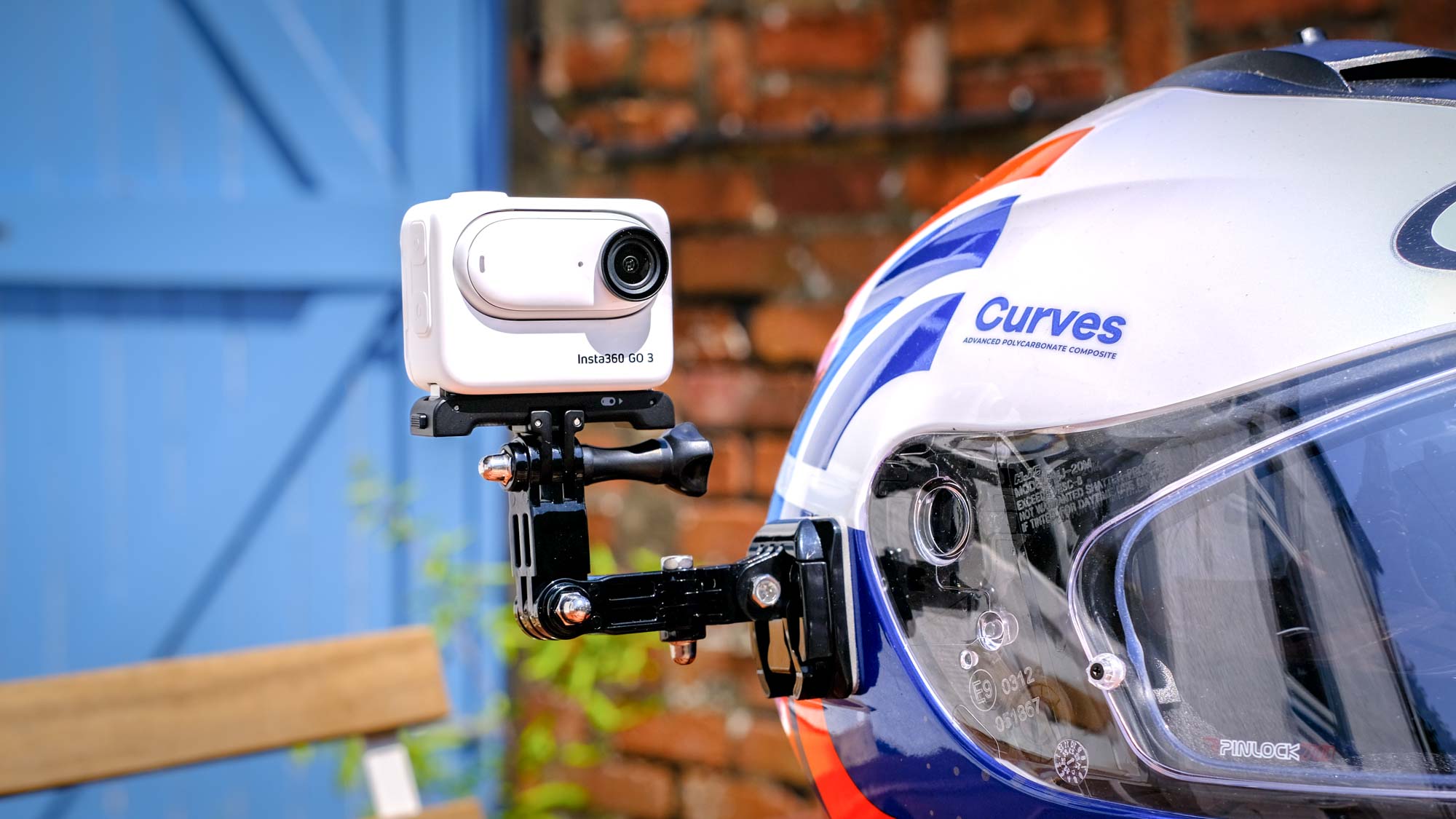
The Insta360 Go 3 is the latest iteration of the company’s smallest and most affordable action camera. Replacing the Insta360 Go 2, the Go 3 aims to give casual content creators and vloggers a pocketable, travel friendly tool for high quality video. Like its predecessor, the Go 3 puts a big focus not only on size and portability, but on being wearable too, allowing you to document your adventures without much trouble or thought.
The Go 3 builds upon the Go 2 in certain areas, such as video performance and recording modes. It also makes a radical departure from some of the standout features of the earlier model. Most notably, the case, previously a case/remote/grip, has been replaced by an Action Pod that turns the Go 3 into more of a classic action camera in both form and function and gives it genuine vlogging potential.
The action camera market is a busy one, though, and the Go 3 is up against some stiff competition, such as the vaunted GoPro Hero11 Black, which ranks top on our list of the best action cameras. In size terms, it’s competing against the GoPro Hero11 Mini. All of these cameras have trade-offs and use cases though, meaning the tiny little Go 3 might be perfect for you, so we’ve tested it in a range of scenarios to help you find out. Read on to see our full Insta360 Go 3 review.
Insta360 Go 3 review: Price and availability
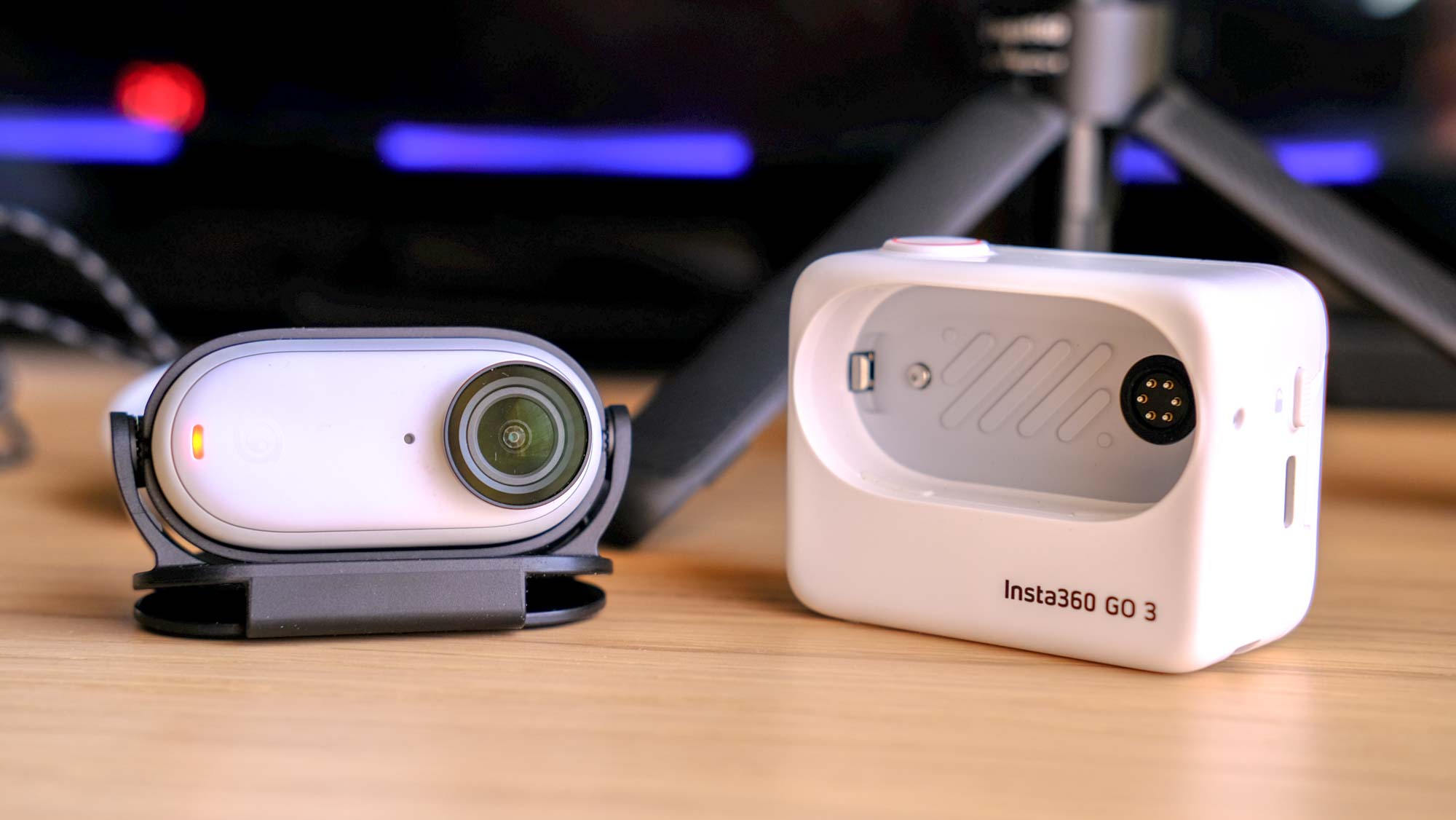
The Insta360 Go 3 went on sale on Jun 27, 2023 and is available worldwide via the Insta360 store and from authorized retailers including Amazon. The company is offering it in three storage options: 32GB ($379), 64GB ($399), and 128GB ($429). Each model includes the Action Pod, the Magnet Pendant, Easy Clip, Pivot Stand, and Lens Guard.
Insta360 also offers a wide range of accessories and mounting kits. We used the 2-in-1 mini tripod and selfie stick ($29), the motorcycle mount bundle ($45), the helmet mount bundle ($19) and the standalone quick release mount ($34). The tripod comes with a version of the quick release mount which uses a ¼” thread, but you’ll want to look carefully into whether the standalone quick release mount is needed when you purchase any of the accessories or mounting bundles — some accessories use the ¼” thread, while others use the the tilting fork attachment system of the standalone quick release mount. The motorcycle bundle, for example, works with the ¼” thread mount, while the helmet bundle works with the tilting fork mount. All the accessories we tried utilized the fantastic magnetic mounting system to attach to the Go 3’s Action Pod, and felt high quality and sturdy.
Bear in mind that there’s no expandable storage, so choose wisely. By comparison, the GoPro Hero 11 Black costs $399, but you have to provide your own storage. For context, our 64GB test version was able to record 2 hours 50 minutes of maximum resolution 2.7K video, so you can effectively halve or double that for the other versions.
Insta360 Go 3 review: Design
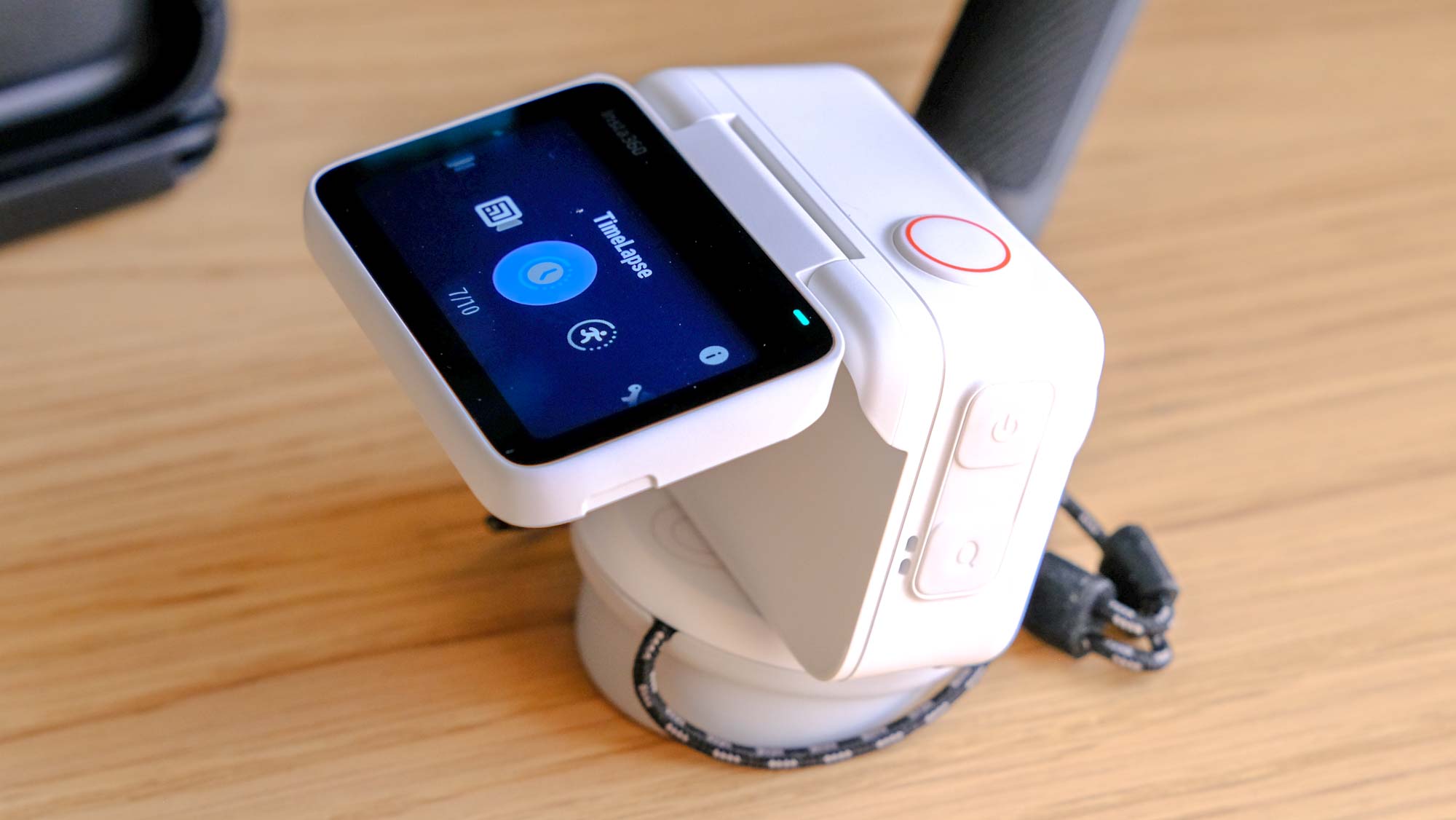
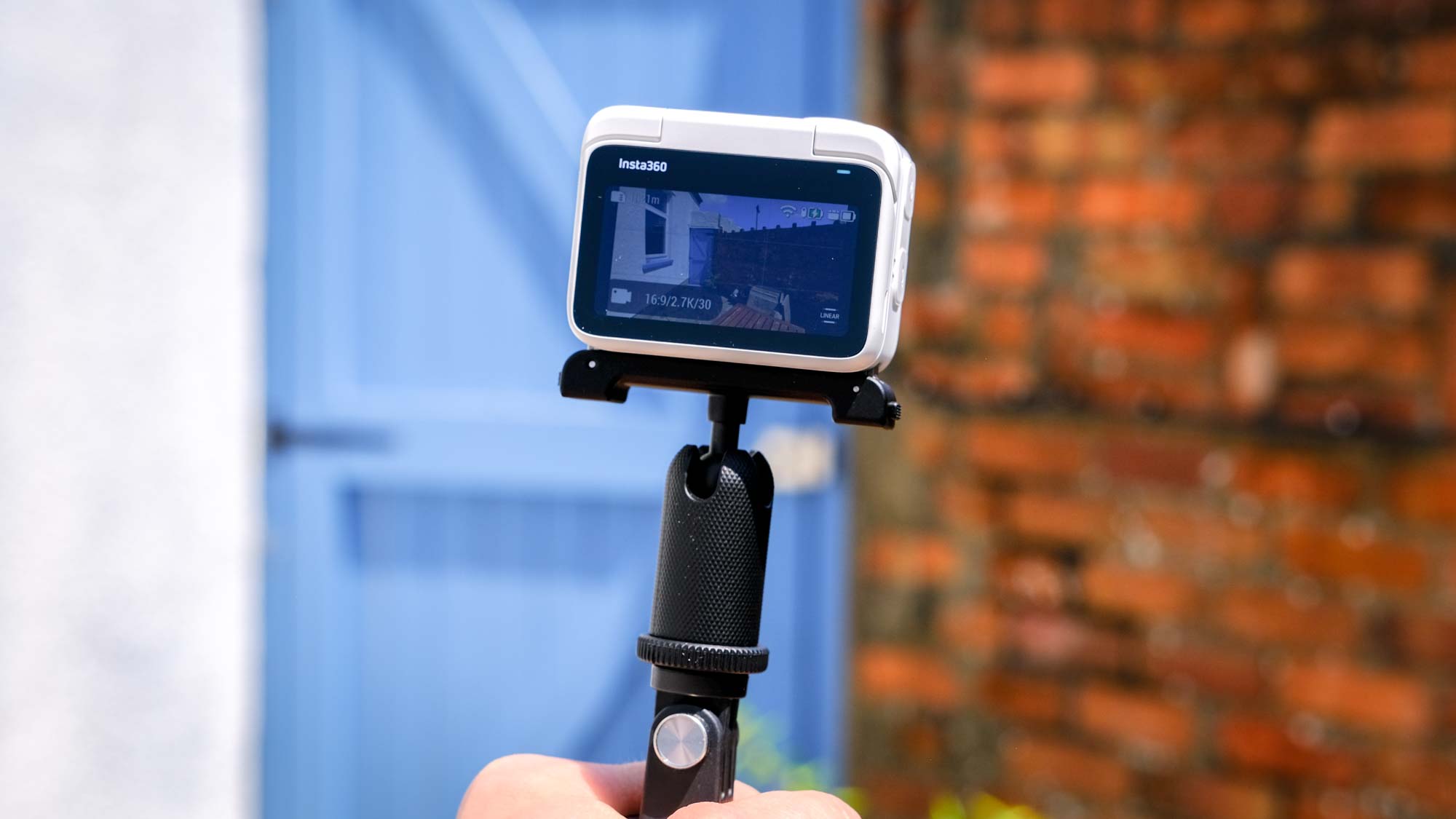
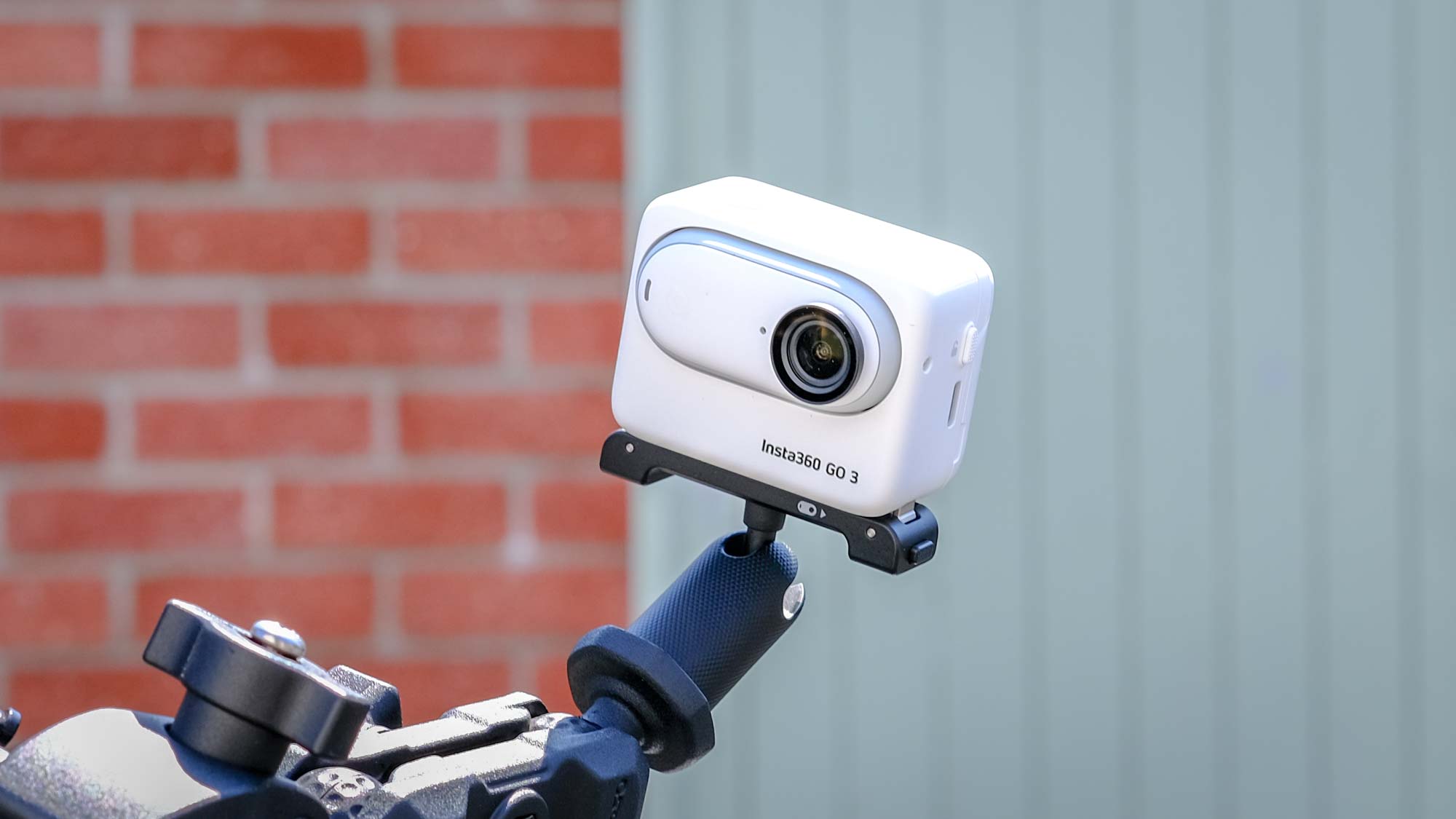
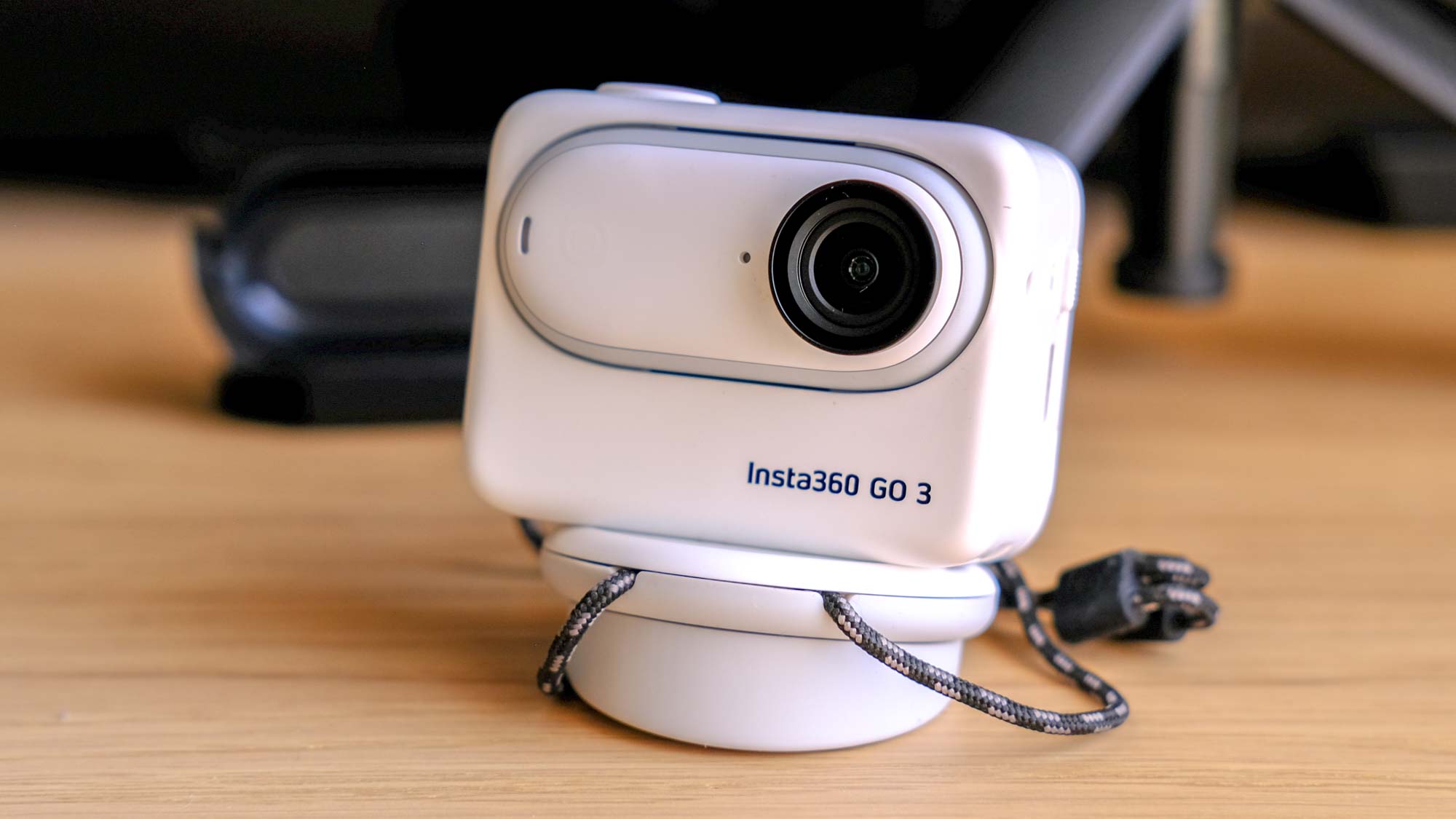
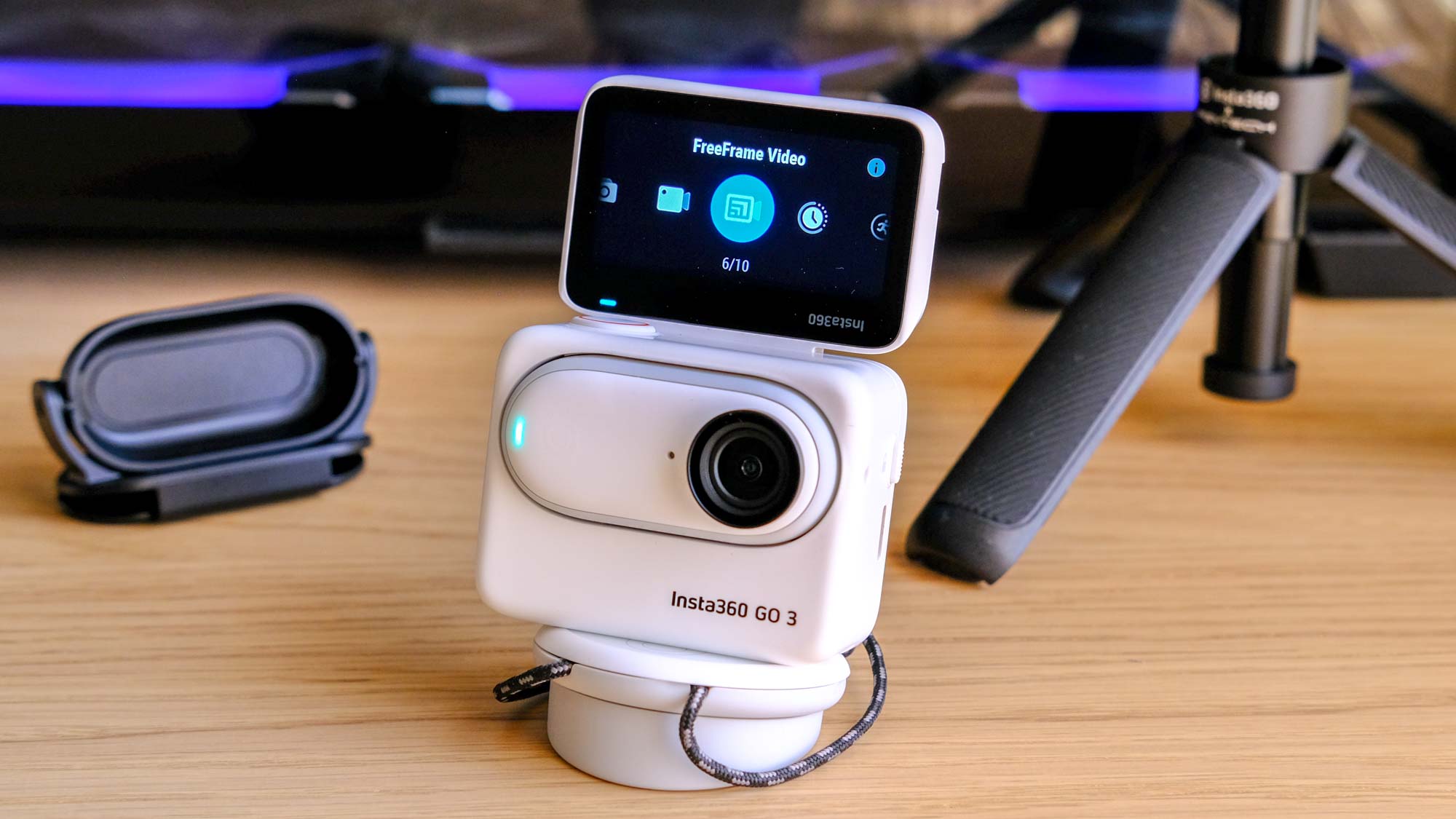
Insta360 has always had some clever designs, but the Go 3 is perhaps the most intriguing yet.
Like the Insta360 Go 2, the Go 3’s camera module is smaller than your thumb; it’s a little oval-shaped device with a lens on one end, and a button built into the body.
Where the Go 2 snapped into something that resembled an AirPods case, the Go 3 docks into a housing, called the Action Pod, that turns the whole affair into something that looks like a GoPro. The Action Pod has a large 2.2-inch touchscreen that flips up vertically, so you can frame yourself in a shot. This is something you won’t find on similarly-sized rival, the GoPro Hero11 Mini, making the Go 3 a better choice for vlogging. In our testing, the screen also came in very handy for lining up the device when mounting on an accessory, to ensure your composure isn’t wonky, especially using the 3x3 composure grid available. When testing it on our motorcycle, it was extremely easy to flick up the screen and double check everything was still lined up — while we were safely stopped, of course.
Max video resolution: 2.7K/30 fps
Size (camera+Pod): 2.5 x 1. 9x 1.2 inches
Weight (camera+Pod): 4.65 ounces
Size (camera): 1.0 x 2.1 x 0.9 inches
Weight (camera): 1.25 ounces
Water resistance (Pod): IPX4
Water resistance (camera): IPX8
Battery: 310mAh (camera), 1270mAh (Action Pod)
The Go 3 can be recharged and controlled from the Action Pod’s screen, as well as from the large Record button on top. The Action Pod also has a power button and a quick record button on its left side and a USB-C port on the right. Cleverly, you can also use the Action Pod as a remote control, so you don’t have to pull out your phone if you want to change a setting on the camera, or see what it’s recording. The Go 3 connects to the Action Pod via a strong magnet and seats with a satisfying thunk. It’s then locked securely and an unlock button needs to be pressed to get it out. One issue we had during testing is that to pull the Go 3 out of its Pod meant pressing the release button and yanking on the lens surround, as there isn’t any kind of pull tab — this may not be a problem and could be the intended way of removing the camera, but it felt a little wrong.
As a unit, the Go 3 and the Action Pod weigh 4.65 ounces and measure 2.5 x 1.9 x 1.2 inches, which remarkably is both smaller and lighter than the similarly priced Hero11 Black (5.4 ounces, 2.8 x 2 x 1.3 inches). The Go 3 is also supplied with a magnetic cap peak mount for the standalone camera, which demonstrates just how light the unit is — testing on the peak of an old, loose fitting tennis hat, it didn't cause the hat to droop at all and stayed put as we moved around.

The bottom of the Action Pod has a magnetic clip attachment on either end which allows it to magnetically hook into quick release mounts. When connected to the included mount, it’s surprisingly strong for something so small and again requires an unlock button to be pressed before the Action Pod can come free. It’s a great system and inspires confidence even when attached to the side of a helmet at freeway speeds. Overall, the form of the Go 3, and the range and quality of official (and affordable) accessories on offer make this a great camera for a wide range of use cases: from sports and adventure, through to vlogging, motoring and even as a dash cam or security camera.
One of the biggest trade offs with the Go 3 versus the GoPro is that the Go 3 lacks any sort of expandable storage, so if you run out of room on the camera, that’s it. In a pinch, though, you can simply export the high res files straight to your phone, then wipe the camera to start fresh.
In addition, the Go 3 isn’t as rugged as the GoPro; while the Go 3’s camera can be submerged in up to 5 meters of water, the Hero11 Black can go down as much as 10 meters. And while the GoPro features a 3.5mm audio jack to hook up a microphone, the Go 3 does not support any external audio whatsoever, meaning you’re stuck with the two onboard microphones. Admittedly, this won’t be a massive problem for much of the target audience wearing the Go 3 on their cap peak or around their neck while walking or exploring.
Insta360 Go 3 review: Video quality
The Insta360 Go 3 features an ultra-wide angle 11.2mm (full frame equivalent) f/2 lens, allowing you to capture a sweeping field of view. There are four field of view modes (ultra-wide, action, linear and narrow), which each essentially step down the field of view. This means you aren’t limited to the fish-eye ultra-wide view and can tailor the look of your footage to what you want or need. It can shoot in landscape or portrait orientation, meaning you can use the camera for YouTube footage or TikTok videos and social media shorts.
Similar to the Hero 11 Black, the Go 3 has a FreeFrame Mode, available in up to 1440p, which lets you change the aspect ratio of your video after you shoot it. There’s also image stabilization, this time up to the beefed-up maximum resolution of 2.7K, which can shoot at 30fps. You can choose from three levels of stabilization, based on the intensity of activity you’re doing — the more stabilization you apply, the more video preview delay you’ll see. 1440p resolution can be shot at 50fps for smoother footage. Then there’s a 1080p mode, which will allow you to record more footage and for longer. However, in terms of overall resolution, the Hero 11 Black, which can record 5.6K video at 30 fps, has the Go 3 beat by a mile.
The Go 3’s 2.7K video still looks great — there’s plenty of detail and 30fps is just enough for footage to avoid looking too choppy. For higher octane action, 1440p at 50fps is obviously a lot smoother, although the drop in resolution was noticeable, making it difficult to discern smaller details in footage. Peter, testing on his motorbike, tried to work out someone’s registration plate when they ran a red light and nearly killed him, but the 1440p footage wasn’t high enough resolution to catch it given the speed the driver was going. Still, 1440p is plenty for awesome looking YouTube content. Feeding into the smoothness of content, there’s also a 360 Horizon Lock in Freeframe Mode which keeps the camera leveled on the horizon, and FlowState image stabilization in general mode, which kept our motorcycling footage free of bumping and shaking, even on rough British roads.
At 2.7K, our Go 3 could record with no video limits until the battery ran out, although footage was broken down into 30-minute chunks. Essentially then, you have no time limit on recording at maximum resolution, meaning your only constraints are battery life and storage space.
The camera’s automatic metering does a great job at exposing properly, even on bright days. In our test motorcycling footage, you can see the camera having to play catch up as we move from shade to bright light, but this was done fairly quickly and accurately. There’s a manual mode available in both the camera and the smartphone app, allowing you to adjust the camera’s basic parameters like color mode, ISO, shutter and white balance, but we found it does a good enough job just left on auto.
For shooting in slightly lower lighting, there’s a low light stabilization mode to help reduce motion blur caused by the auto mode slowing the camera’s shutter speed. You won’t want to use this when it’s too dark, though, as it may reduce image brightness too much. Low light video in general is poor, too, even with the low light stabilization. It’s to be expected from a camera like this with a small image sensor, but if you’re considering lots of nighttime vlogging, the Go 3 is not the tool for you. I tested in the day, but in a room darkened by drawn curtains — in automatic mode, intense noise was visible, which was highly destructive to image quality.
You can also use the Go 3 to shoot slow motion 1080p video at 120fps, although this is weirdly locked to 9:16 portrait orientation. There are two photo modes — HDR and normal — but these are pretty basic. You can change the exposure settings manually, but can’t control where to focus, so realistically the photo mode would only be used in a pinch, as you’d probably be better off just using your phone.
Insta360 Go 3 review: Audio quality
Recording in a quiet environment, the Go 3’s dual internals microphones picked up and relayed voices clearly. It balanced sound well, with whispers audible, and shouting remaining relatively distortion free. There are directional focus and stereo modes, allowing you to customize the mic setup based on your environment and aims.
However, the lack of an external microphone port does strip the “action” out of “action cam” a little, as wearing the Go 3 during fast-paced activities like cycling or motorcycling will generate a lot of wind noise in the footage. There is a Wind Reduction mode but, under testing, it wasn’t able to reduce severe wind noise from motorcycling and couldn’t pick up my voice while riding. If you want to record clean spoken audio while using the Go 3 at speed, you’ll need to use a separate external microphone and sync up the audio in post.
An external microphone port is something we’d have really liked to see in the Go 3, as it would enable better results from a wider breadth of action scenarios, and the lack of one is perhaps this camera’s biggest limitation.
Insta360 Go 3 review: App and features
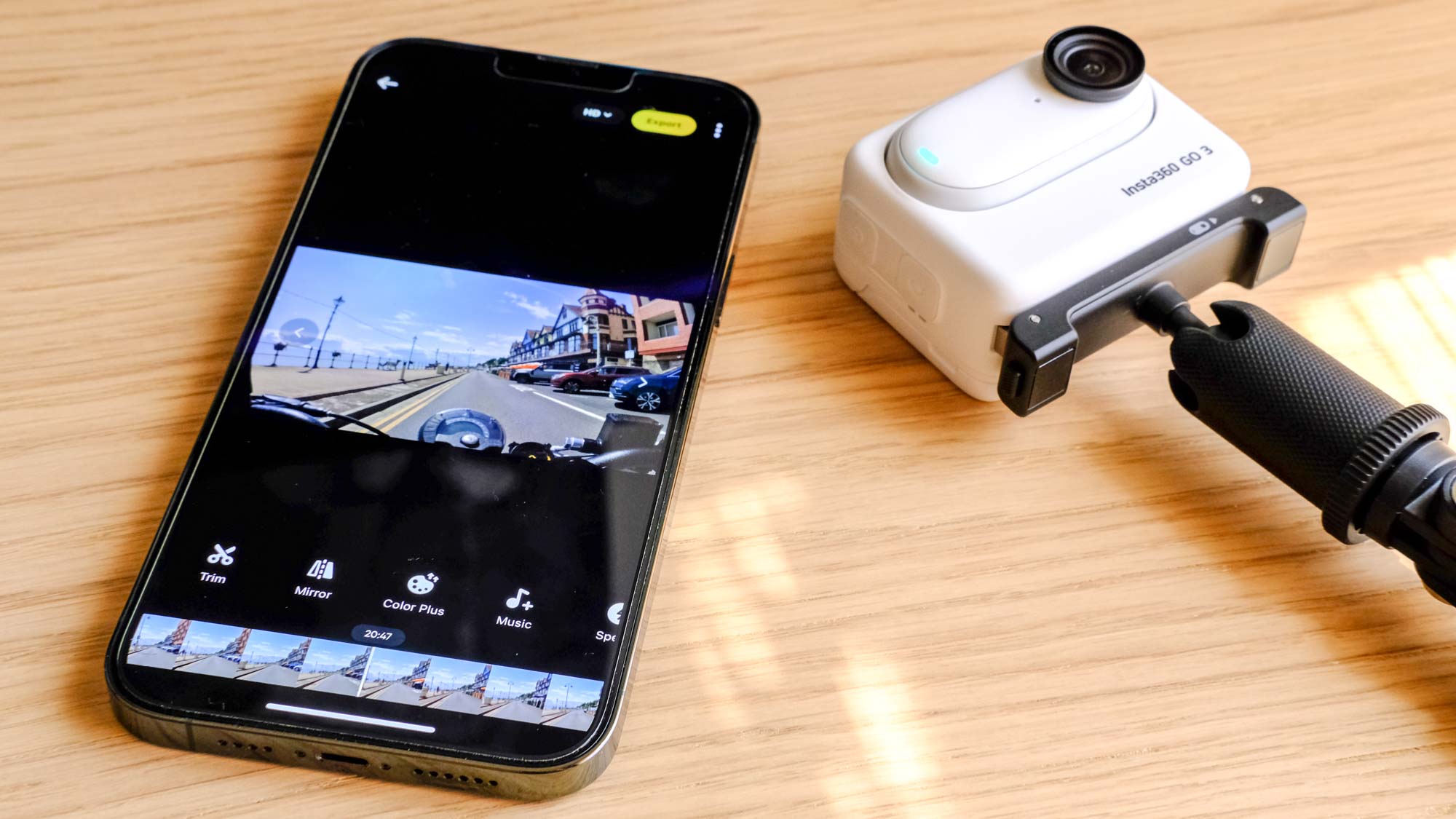
The Insta360 app hooks up to the Go 3 with relative ease, allowing full control over the device from your smartphone. You can use the app to shoot tethered, controlling the exposure parameters and style from the screen, or you can shoot on the device only, then connect to the app to export and edit your footage. (Note: you can also connect the Go 3 to a computer and offload media files directly, if you want to edit at a workstation.)
We had a few difficulties at first hooking up and connecting to the Insta360 app via Bluetooth and Wi-Fi, which could be a bit fussy, and some problems remaining connected while exporting — the app would cut out mid-export. However, we were using a test version of the app as we tested the Go 3 pre-launch. After a firmware update, these issues were totally solved and the pre-launch test app was completely stable.
In the smartphone app, there are a range of color filters to apply to your video before you shoot, including dedicated biking, ocean and nighttime filters. These will allow you to be creative with your content based on the type of action you’re undertaking, and will save you having to edit colors in post production. In the vivid mode, colors look great. Testing on a sunny day, it rendered deep blue skies, warm red and orange tones and vivid greens. Nevertheless, footage felt natural and not overly saturated.
The app gives you a variety of ways to edit your footage after shooting, from adding filters to existing recorded content, through to trimming, snapshotting, mirroring (i.e. flipping the video so you look like you do in the mirror), adjusting color and adding music. You also have a range of standard exposure, temperature and hue controls, face filters and a freeze frame tool — this lets you hold a specific frame for 3, 5 or 10 seconds on screen, and it’s pretty nifty if you want to draw attention to something in your footage. Overall, when it comes to editing, the Insta360 app is an effective tool for people who want to quickly edit and upload content, and avoid the financial outlay and complexity of the best video editing software.
New recording modes are also available, in both the app and standalone camera mode, including Pre-recording, Loop Recording and Timed Capture. The Timed Capture mode is a feature also found on the Hero 11 Black. You can schedule the Go 3 to turn on and start recording at a certain time — handy for when you want to capture a star lapse, but don’t want to wake up at 3 a.m.
Loop Recording will film for a set interval, such as 30 minutes or an hour, before recording over the footage. This is perfect for using the Go 3 as a motor vehicle dash cam, in tandem with the Car Mount ($39) or the Helmet Mount ($19). Pre-recording is great for fast moving situations such as family get-togethers. In this mode, the camera films footage before you’ve even pressed the record button, to make sure you don’t miss things if you aren’t quite quick enough. These features aren’t just gimmicks, and are all very usable in real world scenarios.
Insta360 Go 3 review: Battery life
One of the limitations of the Insta360 Go 2 was that clips were limited to 30 minutes in length, but only if the camera was in a windy environment. Otherwise, the company recommended that you keep the limit to 15 minutes to prevent the camera from overheating. It was an issue when we attached the Go 2 to our cat, as his meanderings far exceeded the time limit on the camera.
The Go 3 no longer has that limitation, featuring a new heat dissipation design. In our testing with the camera in its Action Pod (which serves as a second battery), we could record non-stop until the battery ran out, albeit in consecutive 30-minute videos — that’s 170 minutes! The Go 3 does get a bit warm to the touch, though.
Recording at maximum resolution in standard Video mode on our 64GB version, we achieved just over 2 hours 50 minutes, which is a decent amount of content and essentially the same as the battery life of the camera (in its Action Pod). FreeFrame Video will drop your recording time by almost half, as it takes up more room, but won’t dramatically affect your battery life.
Insta360 Go 3 review: Verdict
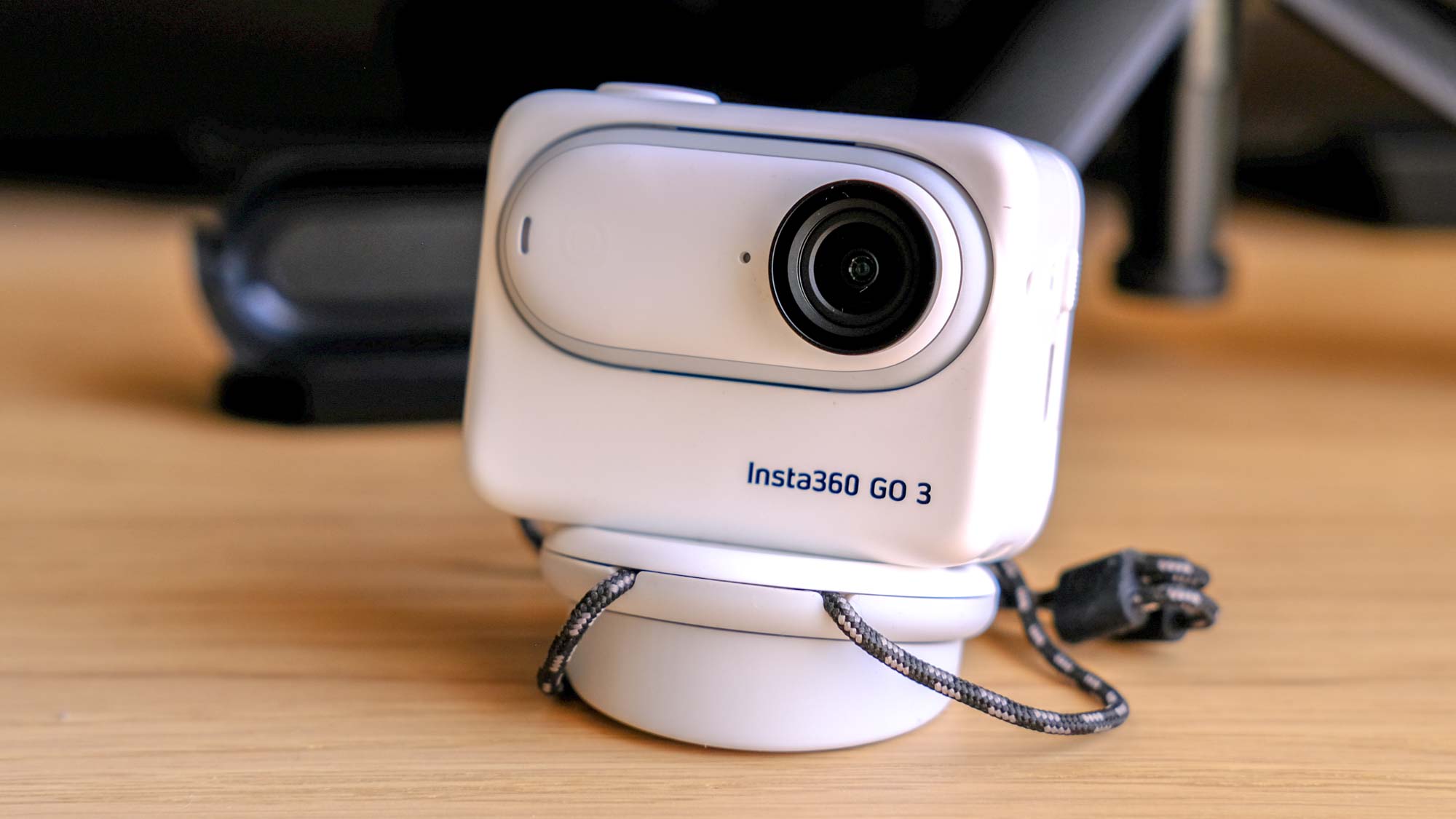
There’s no sense in making an action camera that’s essentially a clone of a GoPro. You just won’t compete. What Insta360 has done — and fairly successfully in our opinion — is create a series of cameras that offer something GoPro doesn’t. This has included 360 cameras and tiny cameras such as the Go 3, whose Lilliputian size lets you do some fun things — like put it on your cat.
If you want an action camera to record professional-grade video, the Go 3 isn’t for you, nor was it designed to be. You’ll want to spend similar money for a GoPro Hero11, so you can shoot 5.3K video at 60p in 10-bit color, hook up a mic for external audio and then jump into a lake. Or, you’ll want to spend a chunk more for an Insta360 X3 if you want to do all of the above and also have access to the awesome third person mode.
However, if you want a lightweight, portable video camera to join you on adventures, sports and vlogging, with enough credentials to produce some nice-looking video with minimal effort, the Go 3 is a compelling little package.







